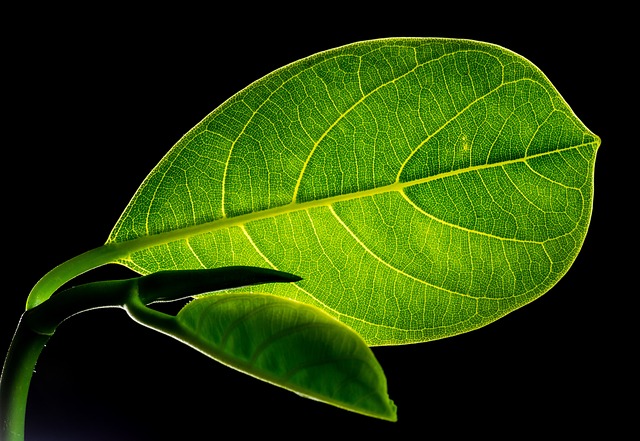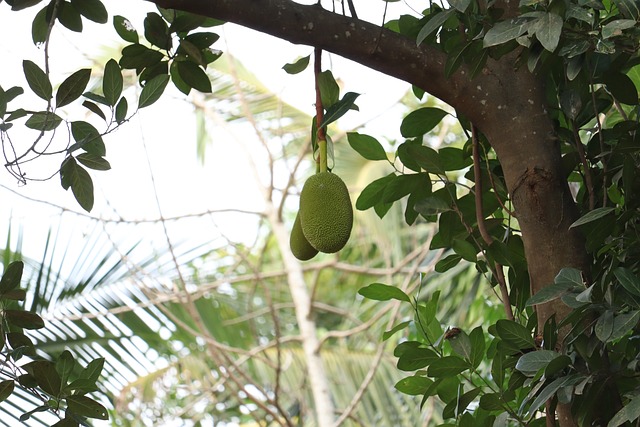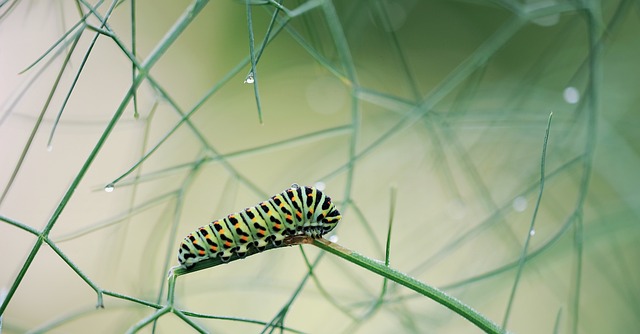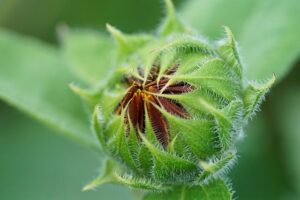
🍫 Green Jackfruit (Artocarpus heterophyllus) is a high-yielding, fast-growing tropical fruit prized for its size and taste. It thrives in warm, humid environments with ideal temperatures between 25 to 30 degrees Celsius, requiring abundant sunlight and organic-rich soil. Agronomists and horticulturists find its growth patterns and potential for sustainable production particularly interesting. The fruit's lifecycle from seed germination to mature tree takes advantage of efficient nutrient absorption and maximizes solar energy use. Within three to four years, green jackfruit trees can produce self-pollinating fruits that, once harvested, are used for culinary or processing purposes. The cultivation of green jackfruit is optimized through careful irrigation, fertilization, and pruning practices, ensuring a substantial and efficient harvest in suitable climates. This makes green jackfruit a valuable crop for tropical regions, offering both environmental sustainability and economic benefits.
Discover the remarkable journey of green jackfruit, a botanical marvel that outpaces many fruits in growth rate, earning it a significant place in agricultural and culinary spheres. This article delves into the rapid lifecycle of green jackfruit, from its initial sowing to the swift maturation of its fruit. Explore how optimal climatic conditions contribute to its swift development, and learn about the cultivation techniques that can further accelerate its growth. Delve into the nutritional advantages and health benefits of incorporating green jackfruit into your diet, and master the art of harvesting at peak ripeness for superior taste and nutrition. As we navigate through processing methods that transform raw fruit into a myriad of culinary delights, we also examine the global impact, including sustainability and economic opportunities it presents. The future of green jackfruit is bright with potential varieties and research advances, offering solutions to cultivation challenges and integrating seamlessly into sustainable agricultural systems. Join us as we explore the versatility and resilience of this fast-growing fruit, from its role in agroforestry to its presence in innovative dishes, ensuring long-term enjoyment through preservation techniques and understanding the science behind its rapid growth trajectory.
- Unveiling the Rapid Growth of Green Jackfruit: A Botanical Marvel
- The Lifecycle of Green Jackfruit: From Sowing to Fruiting with Speed
- Climatic Conditions Favoring the Swift Development of Green Jackfruit
Unveiling the Rapid Growth of Green Jackfruit: A Botanical Marvel

Green jackfruit, a botanical marvel within the morpho diversified family of figs, exhibits one of nature’s most impressive feats of rapid growth. Known scientifically as Artocarpus heterophyllus, this giant of the tropical fruit world captures attention not only for its colossal size but also for the speed at which it matures from a budding artificial seedling to a ripe, fruit-laden tree. Under optimal conditions, green jackfruit can rapidly expand, with the fruits themselves growing to an average size of 8 to 35 kilograms. This extraordinary growth trajectory is not only fascinating but also of significant interest to agronomists and horticulturists alike, as it presents opportunities for efficient crop production in areas with suitable climates.
The rapid development cycle of green jackfruit begins with its seeds, which require a warm and humid environment to germinate and sprout. Once established, the tree’s growth is nothing short of vigorous. The young jackfruit trees exhibit a robust growth rate that continues as they bear fruit. This rapid expansion is supported by the tree’s substantial leaf area and efficient nutrient uptake mechanisms, allowing it to harness solar energy effectively and utilize soil resources optimally. As the fruits swell, they hang heavy and lush from the sturdy branches, promising a bountiful harvest for those who cultivate this resilient and fast-growing fruit species.
The Lifecycle of Green Jackfruit: From Sowing to Fruiting with Speed

The lifecycle of green jackfruit, Artocarpus heterophyllus, is a remarkable testament to the efficiency and productivity of this tropical marvel. From sowing to fruiting, the process exemplifies the plant’s rapid growth potential. The journey begins with selecting a high-quality seed from a mature jackfruit, preferably one that has fallen naturally, as these tend to have higher germination rates. Upon sowing, the seed is placed in moist soil within a warm environment; temperature is a crucial factor for even germination and should be maintained around 27-32 degrees Celsius. Once sprouted, the seedling requires ample space and sunlight for optimal growth, typically requiring six to eight months before transplanting to a field.
Upon translocation to the field, young jackfruit trees need careful cultivation and management. Regular irrigation is essential, especially during the fruiting season when the demand for water is at its peak. Nutrient management through organic or inorganic fertilizers helps ensure that the trees have the necessary resources to grow vigorously. Pruning and training are also vital practices to encourage a strong framework capable of supporting the weighty fruits as they mature. With the right conditions, green jackfruit trees can start fruiting within three to four years post-transplantation. The female flowers, which are self-pollinated, give rise to the iconic green jackfruit, known for its colossal size and heavy yield. As the fruits develop, they require careful monitoring to ensure they receive adequate sunlight without competing too intensely with other branches. When ripe, the green jackfruit can be harvested and prepared for consumption or processing, marking the culmination of a fast-paced lifecycle that is both sustainable and highly productive.
Climatic Conditions Favoring the Swift Development of Green Jackfruit

The rapid development of green jackfruit, a titanic member of the Moraceae family, is most favorably catalyzed under specific climatic conditions. Optimal temperatures ranging between 25 to 30 degrees Celsius and consistent humidity levels are conducive to its swift growth. Ample sunlight, particularly during the early stages of its development, plays a pivotal role in photosynthesis, fostering robust plant structure and vigorous fruiting. Additionally, well-drained fertile soils rich in organic matter contribute to the nutrient uptake necessary for the green jackfruit’s expansive growth. Rainfall distribution, with heavier precipitation during the fruit setting phase, supports the development of the ovaries into mature jackfruit. Farmers often employ strategies such as mulching and irrigation to simulate these favorable conditions, ensuring a bountiful yield of this nutritious fruit. The green jackfruit’s resilience and adaptability to varying environments, when coupled with conducive climatic conditions, allow it to achieve its full potential, both in size and taste, making it a highly sought-after commodity in tropical regions and beyond.
Green Jackfruit’s remarkable growth trajectory, detailed in “Unveiling the Rapid Growth of Green Jackfruit: A Botanical Marvel,” is a testament to its status as a rapid-growing fruit species. The article’s exploration of its lifecycle, from sowing to fruiting, underscores the importance of attentive cultivation practices that are further elucidated in “The Lifecycle of Green Jackfruit: From Sowing to Fruiting with Speed.” The favorable climatic conditions that contribute to this swift development are highlighted in “Climatic Conditions Favoring the Swift Development of Green Jackfruit,” providing valuable insights for growers. Overall, understanding the growth dynamics of Green Jackfruit is crucial for optimizing agricultural yields and sustainability in horticulture.







